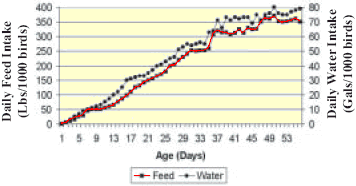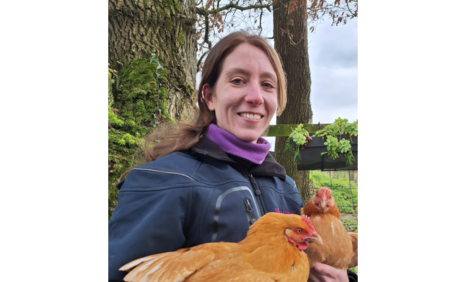



Water Intake: A Good Measure of Broiler Performance
By G. Tom Tabler, Applied Broiler Research Unit Manager at the University of Arkansas's Avian Advice - Raising broilers has its share of aggravations, not the least of which is never knowing how the flock is performing until after the flock is sold and the check shows up. Of course, by this time a new flock may already be in the houses and it is much too late to do anything about the old flock.Introduction
Growers can use daily mortality patterns throughout the flock and visual appraisals to get a general idea of what’s going on, but this is a very subjective measure of performance. Dependable bird and bin scales are commercially available that allow growers to monitor daily feed intake and weight gains. Unfortunately, because of the expense these scales are out of the question for most producers. However, there is a reliable way to accurately measure flock performance that you may already have or can gain access at relatively little expense. Monitoring water consumption on a daily basis has been shown to be a reliable measure of broiler performance.
Are You Delivering Enough Water?
 Water is the most important nutrient consumed by an animal. A bird can survive several
weeks without food, but only a few short days without water. Broilers drink a great deal of water.
During its lifetime, a 5-pound (2.3-kg) broiler will consume about 18 pounds (8.2-kg) of water,
compared to approximately 10 pounds of feed (Lacy, 2002). Pesti and coworkers (1985) estimated
the daily water consumption of broilers by multiplying the age of the bird in days by 0.2 ounces.
Water is the most important nutrient consumed by an animal. A bird can survive several
weeks without food, but only a few short days without water. Broilers drink a great deal of water.
During its lifetime, a 5-pound (2.3-kg) broiler will consume about 18 pounds (8.2-kg) of water,
compared to approximately 10 pounds of feed (Lacy, 2002). Pesti and coworkers (1985) estimated
the daily water consumption of broilers by multiplying the age of the bird in days by 0.2 ounces.
For example, a 10-day old bird will drink about 2 ounces of water during a 24-hr period while a 60-day old bird will drink 12 ounces (or about 355 ml). While it is good to know how much water birds require, it is also important to be sure that water is delivered to your birds. Nearly every grower has houses with nipple watering systems and every grower should have one nipple per 10 to 12 birds at 5 weeks of age.
However, Lott and coworkers (2003) have recently found that nipples with low flow rates can decrease flock performance. These workers found that adequate flow rates (in ml/ minute) could be estimated by multiplying 7 ml times bird age in weeks and adding 20. So,
adequate nipple flow rates for 4-week old birds would be 7 x 4= 28 + 20 = 48 ml/min. Delivering MORE water than the birds need is not a problem, but delivering less can reduce performance.
Water Consumption is Correlated with Feed Consumption
A critical fact that producers may not be aware of is that feed and water consumption are very closely related. Lott and coworkers (2003) estimate the correlation between feed and water consumption at 0.98. In short, this means that when water consumption changes 98% of the time feed consumption changes. Because of this fact, if we accurately monitor daily water consumption, we can get a very good idea of daily feed consumption.
Figure 1 shows daily feed and water consumption patterns for a 56-day flock of male broilers at the Applied Broiler Research Unit. We recorded water in gallons per 1000 birds using our water
meters and feed in pounds per 1000 birds as measured by our feed bin scales. As would be expected, both feed and water intake increase over the 56-day period, but intake becomes somewhat more erratic after day 35. However, notice that when there is an increase or decrease in feed or water
consumption, there is a corresponding increase or decrease in the other. We can use this close correlation to our advantage when assessing flock performance. If water intake is down on any given day, most likely feed intake is also down on that day. If water intake is up, feed intake is most likely up.
Notice also that on the days water intake is down, that day is usually followed by an up day. It is rare for water intake to be down two or more days in a row unless some type of problem is present. Perhaps the flock is getting sick or you ran iodine or bleach that changed the taste of the water. Regardless, if you monitor water intake and it is down two or more days in a row, start looking for a problem because something most likely is wrong. You may wonder if this same feed and water consumption pattern holds true across time or over numerous flocks and the answer is yes, but keep in mind that during summer months when hot weather is a constant challenge to attempts to keep birds cool, the ratio of water to feed will increase somewhat as birds drink additional water in to cool themselves.

* Adapted from 1992 Annual Report.
Tips on Monitoring Water Consumption
One important fact to remember when you monitor water consumption using water meters is to make sure you read the meter at the same time each day. This procedure will assure that you have accurate 24-hour consumption records. Pick a time to read the meter that is convenient for you and stick to it. Some of the more advanced controllers on new or remodeled houses have the capability to read the water meter for you if programmed to do so. Even if your controller cannot do this, it only takes a few seconds to record the meter reading with pencil and paper during one of your regular house checks.
Once you have this type data collected over several flocks, you can begin to compare flocks against each other. Save your records and/or build a database on your home computer that will allow you to quickly access past flocks to compare with your current flock. Most likely, flocks
where you settled near the top of the list will have greater consumption of both feed and water than those flocks where you were average or below. Label your records so that you know how you performed on each flock and this can help you quickly assess the status of your current flock at any time during the grow-out period.
Peak Water Consumption Times and Amounts
Some additional information that you may find useful is when, during the day, water consumption is
at its peak. This information is important when sizing well pumps and supply lines from the water source to the chicken house. Installation of too small diameter pipe in conjunction with a long run from the water source to the chicken house will result in a loss of water pressure by the time water reaches the chicken house. If the pressure drop is great enough, it will be difficult to maintain an adequate supply of water to the birds and cooling systems, especially during times of peak demand.
Data in Table 1 were collected at the Applied Broiler Research Unit on a late summer-early fall flock (August- October) of 56-day old male broilers. Although the data were collected several times per hour, the data were condensed to total weekly consumption to save space. It is important to understand that water intake for the times listed include that water consumed during the previous one hour (i.e., 7:00am includes water consumed from 6:00 am-7:00am; 5:00pm includes water
consumed from 4:00pm-5:00pm, etc.). Our research indicates that peak demand is in the morning, not the afternoon, even though you might think birds would drink the most during the hottest part of the day. Peak demand usually occurs shortly after sunrise or shortly after the lights come on if the lighting program has kept the birds in the dark several hours prior to sunrise.
During the period from day 13-27, peak demand was at the 8:00am hour and during this time the lighting program kept the birds in the dark from shortly after midnight until sunrise. Only a small amount of water was consumed at the 7:00am reading because it was too dark for birds to see to drink until after 7:00am. However, from day 35 until harvest, birds received very little darkness at night and the peak demand time moved to the 9:00am and 10:00am readings. During the 13-27 day period, the birds were thirsty at sunrise and drank before eating. Later on, during the day 35 until harvest period, birds were free to eat and drink most of the night and at sunrise, as light intensity increased, bird activity also increased but they tended to eat first and drink
later.
Highest peak demand was recorded on day 55 during the 8:00am-9:00am hour at 5.55 gals per 1000 birds. Water consumption in the afternoon hours, especially later in the flock, never approached morning usage amounts. Keep in mind, however, that even though water intake by the birds is less in the afternoon, during hot weather fogging and cool cell systems are putting added demands on well pumps and supply lines. Failure to provide adequate size well pumps or supply lines of the proper diameter can seriously reduce water flow to the poultry house to the point that water intake by the birds will be restricted, and therefore, feed intake and growth rate will also be restricted.
When remodeling or retrofitting, be aware that you may need to install a bigger pump or larger supply lines to provide an adequate water supply. Make sure supply lines from the water source to the chicken house are large enough to prevent a huge pressure drop before water reaches the chicken house.

1 Adapted from 1992 Annual Report
Summary
Monitoring daily water consumption is a reliable measure of broiler performance and is much less expensive than bird or feed bin scales. Feed and water consumption are very closely correlated so that if you know water intake you can closely estimate feed intake. Water meters are fairly inexpensive and when used properly can be an excellent management tool. The key is to read the meter at the same time every day. Keep a record of water intake throughout the flock and, after several flocks, you will have a database of information you can use to compare the performance of your current flock against past flocks. In this manner, performance could be monitored on a daily basis or break flocks into weeks and compare performance on a weekly basis. A weekly basis may be somewhat more advantageous because it will average out some of the variability that can occur on a day-to-day basis. Be aware of the peak water demand at your farm and make sure you have adequate pump capacity and piping diameter to more than meet this demand. Remember that restricting water intake will also restrict feed intake and bird performance.
References
1992 Annual Report. Broiler Research Verification for Energy Efficiency and Optimum Production. Cooperative Extension Service and Agricultural Experiment Station, University of Arkansas, Fayetteville.
Lacy, M. P. 2002. Broiler management. Pages 829-868 in: Commercial Chicken Meat and Egg Production (D. B. Bell and W. D. Weaver, Eds.) 5th Ed.
Lott, B. D., W. A. Dozier, J. D. Simmons and W. B. Roush. 2003. Water flow rates in commercial broiler houses. Poultry Science 82(Suppl. 1):102 [S56].
Pesti, G. M., S. V. Amato, and L. R. Minear. 1985. Water consumption of broiler chickens under commercial conditions. Poultry Sci. 64:803-808.

Source: Avian Advice - Fall 2003 - Volume 5, Number 3









